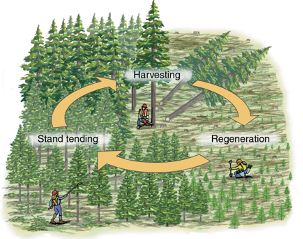
What is silviculture and why is it an important aspect of forestry? Silviculture is the art and science of cultivating trees in a forest for ecological and economical advantage. It is the controlling of a forest based on establishment, structure, composition, and growth. There are six main principles of silviculture which include the imitation of nature, conservation of site productivity, and the control of structure, composition, stand density, and rotation length.
Forests are constantly experiencing disease, climate change, and many forms of disturbances. Through these disturbances, foresters use silvicultural practices to maintain a forest that imitates nature. Silviculture is an important science that is used to maintain our forests to promote growth and maintain species composition. There are two type of silvicultural treatments: regeneration treatments and intermediate treatments.
Regeneration treatments are used to establish a new age class of trees through harvesting. Regeneration treatments are commonly used when a stand needs harvesting. The term stand is defined as a contiguous group of trees that are generally uniform in species, composition, age class, site quality, and the condition to be a distinguishable unit. There are different types of harvesting methods that are used based on the goals of the forester. For example, a common regeneration treatment in Oak forests is a shelterwood method. Shelterwoods are generally done in 2-3 steps. This is where a treatment on a stand is done to establish regeneration throughout the entirety of the stand. Once regeneration is prominent in the understory the overstory is harvested. This establishes a new age stand through manipulated regeneration.
Intermediate treatments are used to enhance the growth and quality of a stand’s composition. This is done with the use of thinning’s. Just like with harvesting methods there are different thinning methods that are used based on the intentions of the forester. There are five specific thinning methods: Low, Crown, Dominant, Geometric, and Free Thinning. Each of these methods are used in different situations for different end results. Silvicultural practices are vital to the health, reproduction, and quality of our forests.
Foresters consistently use silviculture practices in their work. If you believe you have an interest in silviculture, the best way to learn more is by doing more personal research to determine if a career in traditional forestry is right for you. A Forestry major will pave the way for you to become a traditional forester that will use silvicultural practices daily.
Ralph D. Nyland, Laura S. Kenefic, Kimberly K. Bohn, and Susan L. Stout. Silviculture Concepts and Applications, Third Edition. Waveland Press, Inc. 1996
